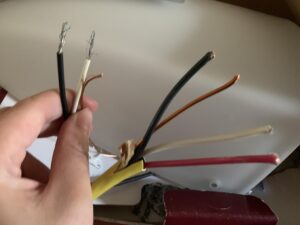What is a 4 Wire? How to Connect 4 Wire?A “4-wire” connection typically refers to a type of electrical or electronic connection that involves four separate conductors or wires.
This configuration is commonly used in various applications, including electrical circuits, telecommunications, networking, and instrumentation.
In this guide, we’ll delve into the details of what a 4-wire connection is, its applications, and how to properly connect one.
Understanding 4-Wire Connections:
A 4-wire connection consists of four individual conductors bundled together within a single cable or assembly. Each wire serves a specific purpose, and the configuration may vary depending on the application. However, a typical 4-wire setup includes the following:
What is a 4 Wire? How to Connect 4 Wire?
- Power Wires (Positive and Negative)
: These wires deliver electrical power to the device or system. The positive wire (+) carries the current from the power source, while the negative wire (-) completes the circuit and returns the current to the source. - These wires are usually colour-coded for easy identification, with red often used for positive and black for negative.
- Signal Wires: Signal wires transmit data or control signals between components. Depending on the application, these wires may carry analog or digital signals, such as audio, video, sensor data, or communication protocols like RS-232, RS-485, or Ethernet.
- The signal wires are crucial for the proper functioning of the system and must be connected correctly to ensure reliable communication.
Applications of 4-Wire Connections:

4-wire connections are widely used in various fields due to their versatility and reliability. Some common applications include:
- Electrical Circuits: In electrical wiring and circuitry, 4-wire connections are utilised for power distribution, control systems, and sensor networks. They allow for separate routing of power and signal wires, minimising interference and ensuring accurate data transmission.
- Telecommunications and Networking: Ethernet cables, which are commonly used for networking purposes, consist of four twisted pairs of wires, making them a 4-wire configuration. Each pair carries signals in both directions, enabling high-speed data transfer between devices.
- Instrumentation and Measurement: Test and measurement equipment often employ 4-wire connections for accurate readings and precise control. This includes devices such as multimeters, temperature sensors, strain gauges, and pressure transducers.
- Audio and Video Systems: Audiovisual equipment, including speakers, microphones, cameras, and displays, may utilise 4-wire connections to transmit audio and video signals with minim distortion.
How to Connect 4-Wire:
Properly connecting a 4-wire setup is essential to ensure the functionality and safety of the system. Here’s a step-by-step guide on how to connect a typical 4-wire configuration:
- Identify the Wires: Begin by identifying each wire in the 4-wire cable. Typically, the wires are colour-coded for easy identification. If not, use a multimeter to determine which wire corresponds to each function (power, ground, signal).
- Prepare the Wires: Strip a small portion of insulation from the end of each wire using wire strippers, exposing the metal conductor underneath. Be careful not to damage the conductors while stripping the insulation.
- Connect the Power Wires: If you’re connecting to a power source, such as a battery or power supply, connect the positive (+) wire to the positive terminal and the negative (-) wire to the negative terminal. Ensure tight and secure connections to prevent accidental disconnection or short circuits.
- Connect the Signal Wires: If your application involves transmitting signals, connect the signal wires according to the specific requirements of your system. For example, in an Ethernet connection, match each twisted pair of wires to the corresponding pins on the connectors (e.g., RJ45).
- Test the Connection: Once all the wires are properly connected, perform a thorough test to verify the functionality of the system. Check for proper power delivery, signal transmission, and any potential issues such as shorts or open circuits.
- Secure the Connections: After confirming that everything is working correctly, secure the connections using appropriate methods such as crimping, soldering, or using wire nuts. This will help prevent accidental disconnections and ensure long-term reliability.
Conclusion:
In summary, a 4-wire connection involves four individual conductors used for various purposes such as power distribution, signal transmission, and control. Understanding how to properly connect a 4-wire setup is crucial for ensuring the functionality and safety of electrical and electronic systems across a wide range of applications. By following the steps outlined in this guide, you can effectively connect 4-wire configurations with confidence and reliability.
Read Also.how long does it take to drain a water heater?